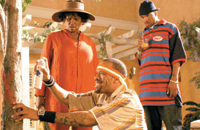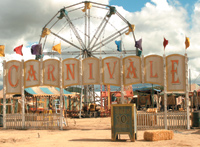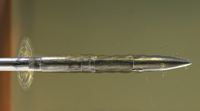
FotoKem used a traditional HD workflow while finishing the Fox pilot Method and Red, which is shot on 24p HD.
|
The HDTV trend has definitely caught fire with the major broadcasters. Now, major networks, such as CBS and HBO, are routinely requesting that producers supply them with a high-quality HD master for HDTV broadcast. In fact, the CBS program delivery specification for the 2004-2005 season includes the option for producers to deliver their shows in 5.1-channel surround sound. (CBS has a separate HDTV channel in which they feed an HD signal to their affiliates who then deliver it on a separate DTV/HD channel if they choose to broadcast in HD. It's a "channel" in which the HD signal travels as opposed to a service.)
While the networks are all rowing in the same direction with respect to HDTV, television productions have fallen into two camps. Situation comedies, which tend to be multi-camera shoots on a soundstage, have largely embraced HD acquisition due to HD's significant cost savings over 35mm film. But, many television episodics are staunchly clinging to 35mm film because producers feel that only film can give them the desired dynamic range in the toughest lighting situations, as well as creative options, like in-camera effects, that enhance their storytelling.
At any rate, 1080/24 (23.98) progressive, also known as 24p HD, has become the format of choice for production even though 1080/60 (59.94) interlaced is the predominant HDTV format for America's ATSC standard. And, the biggest selling point of 24p HD is that it makes an excellent springboard for generating superior versions - in PAL, letterboxed, SDTV, even film - for delivery to the growing universe of media outlets.
CBS'S HUGE COMMITMENT

Even though their series are shot on Super 35mm, HBO has made a commitment to airing many in HD, including Carnivale.
|
"Of the 96 TV shows in production across all networks, 37 are shooting 1080/24p HD. That really underscores the inroads1080/24p HD is making," says Robert Seidel, VP engineering, advanced technology for the CBS Television Network (www.cbs.com/) in New York. "At CBS, many shows have been successful shooting 24p HD, such as the drama Joan of Arcadia. We have broadcast many specials in 24p HD, including this year's Victoria's Secret [Fashion Extravaganza], and our sister network MTV has produced the MTV Music Awards. Besides superior picture quality, cost is a primary motivation behind the adoption of 1080/24p HD acquisition. It costs about $70 per minute per camera to shoot 35mm film when you factor in the cost of film stock, lab processing, film-to-tape transfer and color correction. Since situation comedies shoot with four to five cameras to capture a live, spontaneous feel, the cost for shooting film is substantial. Whereas, if the show shoots in HD, the cost is only about $2 per minute per camera, resulting in significant savings on below-the-line costs."
Another important motivation to working in HD resolution is that it provides an excellent springboard for international distribution. "Both 1080/60i and 1080/24p have been recognized by the ITU [International Telecommunications Union], the technology arm of the United Nations, as the international HD exchange format," says Seidel. "And 1080/24p is especially ideal for converting to 25fps for European distribution. We've been very successful distributing our shows to Japan, South Korea and Australia, which have adopted HDTV. And there are signs that Europe is realizing they are behind the curve by not broadcasting in HDTV."
In most cases, primetime audio is Dolby Pro Logic four-channel matrixed sound, especially dramas which tend of have a dialogue track in the center. However, Seidel says, "We have produced shows in 5.1-channel surround sound wherever we felt it would have the most impact. For example, we produced the Grammy Awards [in 2003 and 2004] in HD with 5.1-channel surround sound. Because all the artists wanted their own microphone and mix, we ended up dealing with over 800 audio sources, but we felt that the show portrayed the best attributes of 5.1 sound to consumers." The 2003 Grammy telecast received an Emmy for "Best Sound Mix."
HDTV and 5.1-channel surround sound were also used for live telecasts of the 2002 and 2003 NCAA football and NCAA Final Four basketball tournaments; NFL post season games and Super Bowl XXXVIII; and the US Open Tennis and Golf events - to allow viewers to truly experience the games. For the past five years, CBS has been airing all of its primetime dramas and comedies in HDTV. During the 2004-2005 television season, CBS will be airing 19 of its shows in HDTV, including JAG, CSI and CSI Miami.
HBO SHOOTS FILM, MASTERS HD

When Zoic supplies visual effects for shows like CSI Miami, they are in full CG and HD.
|
"HD affords us creative choices that SD doesn't. In HD, color correction is more flexible and visual effects are more robust," says Gena Desclos, director post production for HBO in Los Angeles. "HD not only makes the HDTV broadcast look great, it also makes the SD version look better as well. After HBO shows like Six Feet Under, The Sopranos, Carnivale and Deadwood air on our HDTV channel, the HD D-5 master is used to generate the SD master for the repeat showings on our SD channels."
HBO shows are shot in Super 35mm film, with shots composed for HD's widescreen 16:9 aspect ratio. For the SD versions, pan and scan work or letterboxing is done as necessary. In post, everything - the editorial, effects, color correction, titles and more - stays in 24p HD until the HDTV master is done in 1080/60i on D-5. The shows are offlined on SD Avids, but finishing is done in either an HD linear bay or on an HD NLE depending on the specific needs of the show. The final HD D-5 master is then used to generate all the SD masters needed for multicast, such as the Spanish version.
"With that 24p HD master, you really can create every deliverable you would ever need for domestic and international television," says Bruce Richmond, VP of original programming for HBO. "24p HD really has delivered on the promise of being a high-resolution format that really can satisfy any delivery requirement we may have today, and even into the future." HBO uses Riot Santa Monica and Encore in Hollywood.
HD FINISHING
At Technicolor Creative Services (TCS) in Hollywood, there are just under 20 television series in post production simultaneously, most of which are being finished in HD for HDTV. "The current state is that all broadcast networks are requesting HD masters, except for older series that are basically grandfathered," says Marco Bario, senior VP, TCS/Hollywood.
"In terms of trends, four-camera comedies almost exclusively shoot in HD, with very few exceptions. And single-camera shows almost exclusively shoot film, with only a couple of exceptions," reports Bario.
One exception is the Charlie Sheen comedy Two and a Half Men (for CBS), which Bario says prefers to shoot film for creative reasons." Other HDTV shows in the works at TCS/Hollywood are: 8 Simple Rules, (ABC); Grounded for Life, (WB); American Dreams, (NBC); and the NBC crime drama Crossing Jordan.
"We also do all the visual effects work for Star Trek: Enterprise [UPN], all of which is delivered in HD. Three rooms support that project with Inferno and Flame," says Bario. "Being a large company, we were able to invest heavily in HD and today our entire infrastructure is HD-capable, including film-to-tape transfer suites [with eight Thomson Spirit telecines and eight da Vinci 2K color correctors], online finishing and visual effects suites."
HUFF SHOT IN HIGH DEF

Shot in Super 16mm, telecined to HD and finished at FotoKem's Keep Me Posted on Discreet Fire, reports FotoKem's television and film group VP, Scott Levitta. The NBC miniseries Helter Skelter shot 35mm while
|
"HD has a nice look but I wouldn't say it's a film look. It's a very pretty image with a certain sense of naturalism," says Rohn Schmidt, a Hollywood-based independent director of photography who is the DP on a new fall 2004 show called Huff for Showtime. As a DP experienced in film, Huff is Schmidt's first time shooting on HD.
Described as a "dramedy," Huff focuses on the life and times of a psychiatrist named Dr. Huff (played by Hank Azaria) and his family and friends. The show is shot on a soundstage, which provides a very controlled lighting environment.
"Next to the soundstage are several Avid [Meridian] cutting rooms for offline editing, and the close proximity to the set enables the director, DP and other production people to be involved in that process," says Dauri Chase, the co-producer for Huff, at Allenford Productions, a division of Sony, in Sylmar, CA.
"We love HD," says Chase. "The imagery is pristine." Encore Video in Hollywood handles the HD online editorial in 1080/24p HD and the sound mix is done at Hollywood's Todd-AO. According to Chase, the show is mastered on D-5 HD and no film master is made for archive.
"I find that HD is not dramatically different from film," says Schmidt. "You need to respect the HD medium and understand its limitations, just as you would respect the limitations of film. I'm shooting it 'a little flat' with plans to add contrast in post production. Also, this is a film-style shoot with filmic lighting, filters, diffusers, dollies and other conventional film production tools." Because the look is tightly controlled on the set, Schmidt says there is not much color correction needed except to match the images.

Dead Like Me switehes to HD
|
"Over the years, I've come to really appreciate what colorists can do for a film. Colorists are seen by most DPs as an ally who can help them carry out their vision and dream for the look of the film," says Schmidt. "I've also come to realize that HD is a very good medium now, and with the upcoming refinements that we are expecting to see in the next two to three years, HD's going to be great."
HD VFX
For CSI Miami on CBS, the challenge is to create all the show's visual effects in full CG and HD, while adhering to a television production schedule and budget. "These are tough shots - not just greenscreen pulls. We've created a realistic sinking of a 3D CG Spanish Gallion, a multilayered composite to depict the Everglades on fire, tornadoes, hurricanes and plane crashes," says Andrew Orloff, visual effects supervisor for Zoic Studios (www.zoicstudios.com/) in Culver City, CA
"And CSI: Miami is just one of the shows that we work on. In pilot season, we're putting out 150 HD-resolution effects shots every week, and they're major motion picture quality sequences," says Orloff. Since 1920 x 1080 HD resolution demands eight times the processing power of 720 x 486 SD resolution, Zoic buys PC components like memory boards and disk drives in bulk and configures them to handle the huge workload.
Besides the 300-processor renderfarm, Zoic is running Alias Maya and NewTek LightWave 3D, along with Discreet's Combustion and Adobe After Effects for 2D compositing. Much of the work is done using low-rez proxies, with high-resolution rendering done as a background process.
Zoic also provided visual effects for last season's Battlestar Gallactica, a re-make of the 1980's television series that centered on a spaceship. Orloff says, "This re-make, which had full 3D CG HD effects in it, has since been picked up by The SciFi Network, and we'll be doing the series work as well."
FINISHING WORKFLOW
Seeing that the HD finishing market was growing, last year, Burbank's FotoKem (www.fotokem.com/) acquired the edit boutique Keep Me Posted, along with an array of HD-capable creative finishing systems and talent to complement its full-service lab.
"Several trends motivated us to combine HD creative services with our 41 years of laboratory and HD mastering expertise," says Rand Gladden, senior VP of digital and data development for FotoKem. "The major networks are almost exclusively HDTV in primetime. At some point, television will be entirely HDTV. Secondly, the demand for HD is pushing post production toward a totally data-centric model. And finally, budget pressures are forcing facilities to look at creative ways to finish shows faster, with higher quality and lower cost."
FotoKem used a traditional HD workflow for finishing several recent projects. Riverman for Fox and Mystery Girl for UPN were each shot in Super 16mm, telecined to HD and finished at FotoKem's Keep Me Posted on Discreet Fire, reports FotoKem's television and film group VP, Scott Levitta. The NBC miniseries Helter Skelter shot 35mm while Fox's pilot Method and Red shot 24p. Each production used a different acquisition method, yet they all followed what Gladden describes as a "tape-to-tape-to-tape" finishing process. Even current NLE finishing systems, he notes, require laying off to tape at each stage of the post process.
For Method and Red, FotoKem synced the 24p dailies to a new HD master while KMP supplied the Avid Media Composer and production suites for the offline. The main title treatment was constructed on a Final Cut Pro station in KMP's graphics suite and married to the HD online on a Discreet Fire. FotoKem used their da Vinci 2K for the HD color correction while KMP did the title pre-build and graphics in their HD Deko. Method and Red then went back to the Discreet Fire for a final title pass.
However, Gladden sees new economies developing in HD post production as FotoKem moves to a more efficient data-centric path for finishing HD projects. "This may include working at higher resolutions than HD and merging some of the technologies that have been developed for the digital intermediate environment into television post services. Converting the processed film to data, or using data capture during production, provides several significant advantages for the facility and the studio. On the post side, maintaining the material as data in a common storage environment gives us access to it during any of the various stages, be it editorial, color correction, graphics and effects, online finishing, duplication, archiving and ultimately electronic distribution of the final content. The data-centric method reduces the necessity to continually have to master and remaster to a tape format.
"The studio or production company can archive that data for later on when it may need additional elements for worldwide distribution or syndication or DVD purposes," Gladden continues. "That way we have it at the highest resolution possible for any of the newer formats that may come along later. Posting at higher resolutions gives studios more options for recouping their investment through repurposing with a more cost-effective process."
Working at higher resolutions provides another answer to the better quality - lower cost equation, adds Gladden. "Shooting 16mm on what would have been a 35mm project offers significant cost savings to a production for each episode, yet doesn't impact the quality of elements available down the line. High resolution data preserves the elements for creating HD DVDs, or taking those elements and reformatting them to put on servers for on-demand distribution, as well as the ability to create a new, finished film negative."
Many of the experts we talked to indicated that making a film version, or doing a "film out," is not as high a priority as it would be for a cinematic project. While film masters are ideal, they will be made as time allows. They also indicated that repurposing classic television series to air anew on HDTV is a revenue center that will also increase along with the HDTV trend.